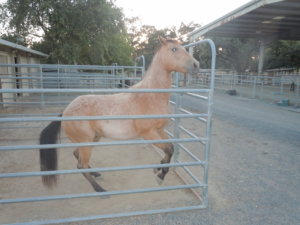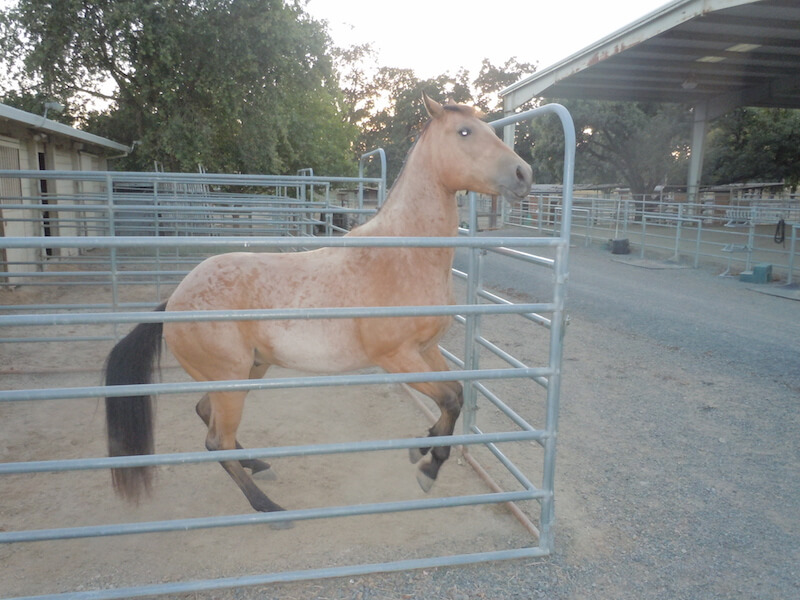The Steps to Breaking a Dangerous Cycle
by Raye Lochert
 Barn or buddy sour horses are not much fun. They can be downright dangerous. When they’re acting up they aren’t listening to the rider. This can lead to injury for horse, rider, or both. So how do you fix this? It takes time and consistency. If you are looking for a quick fix don’t bother reading, there isn’t one.
Barn or buddy sour horses are not much fun. They can be downright dangerous. When they’re acting up they aren’t listening to the rider. This can lead to injury for horse, rider, or both. So how do you fix this? It takes time and consistency. If you are looking for a quick fix don’t bother reading, there isn’t one.
Understand that this is an emotional issue. The horse is afraid to ride off without his security. When the horse is afraid we tend to get scared and/or angry. Then the horse will become afraid of us or the situation. Safety is the primary goal here – safety for ourselves first and also for the horse. When the horse’s emotions go up his performance will go down. He is thinking of whatever is bothering him instead of what you are asking him to do. We need to work the horse in his comfort zone and then expand that zone to raise his emotions, but not so high that we lose control before bringing them back down again. Sometimes you will make great progress and then you will regress, this is natural. Let’s get started.
Controlling the horse’s hindquarters is key to everything you do with your horse. You should be able to pick up the left rein and get the hip to move to the right and vice versa. While the hip is moving the front end should have stopped. By getting the hindquarters to move around the front end you will get the horse to stop which, in turn, will lower his emotions. With emotion comes speed and running away is a horse’s best defense. Through repetition and raising and lowering a horse’s speed and emotion fear will subside. Eventually the horse will no longer associate fear and speed together. Once you have control of the horse’s hindquarters you are ready to move on to training. Buddy sour and barn sour are the same thing and this method can be used on either issue.
At first, ride as close as you need to the buddy (barn) so that your horse is comfortable. Then turn the two horses so that their tails are facing each other and then immediately back before the horse gets emotional. You just want to raise his heart rate a bit. Always bring the horse back to where he is comfortable before he gets upset. By lowering his emotions before he reacts you are bumping his emotional threshold higher. Gradually increase the time they are facing away from each other, then increase the distance they are apart. There is no point in being able to get your horse 500 feet away from the other horse if he has to be back there in 30 seconds. On the other hand there is no value to being 5 feet away for 4 hours. Work on the two issues separately but interchangeably.
Once you can keep you horse facing the other way for say 5 minutes try and get 10 feet away but come back in two minutes. Then try to get 10 feet away for 3 minutes and so on. Now if your horse is only comfortable at 8 feet then work there. After your horse is comfortable at 10 feet away for 10 minutes, move to 15 feet away for 2 minutes. Do you see where this is going? All the while the horses can see each other. Each time you are taking them further away for shorter then longer periods of time. Each time you are coming back to the horse’s comfort zone before they get too excited. Once you can ride away to say about 200 feet and stay away for 15 minutes you are ready to move on to the next part.
Ride out of sight of the other horse and then ride right back. Don’t even give your horse a chance to realize that they can’t see their buddy. At times you may ride back into view, but not all the way back. See if you can break the cycle of always having to go back to the other horse. Gradually increase the time until you feel you can stay away indefinitely.
There will be times when you have worked your way up to a great distance or amount of time and the next time you go out you can’t get half as far. This is normal. Always ride back before the horse gets emotional. This way they don’t see their actions as a way to find release. In the end your horse will learn that you are all they need to feel secure.
Published November 2011 Issue

